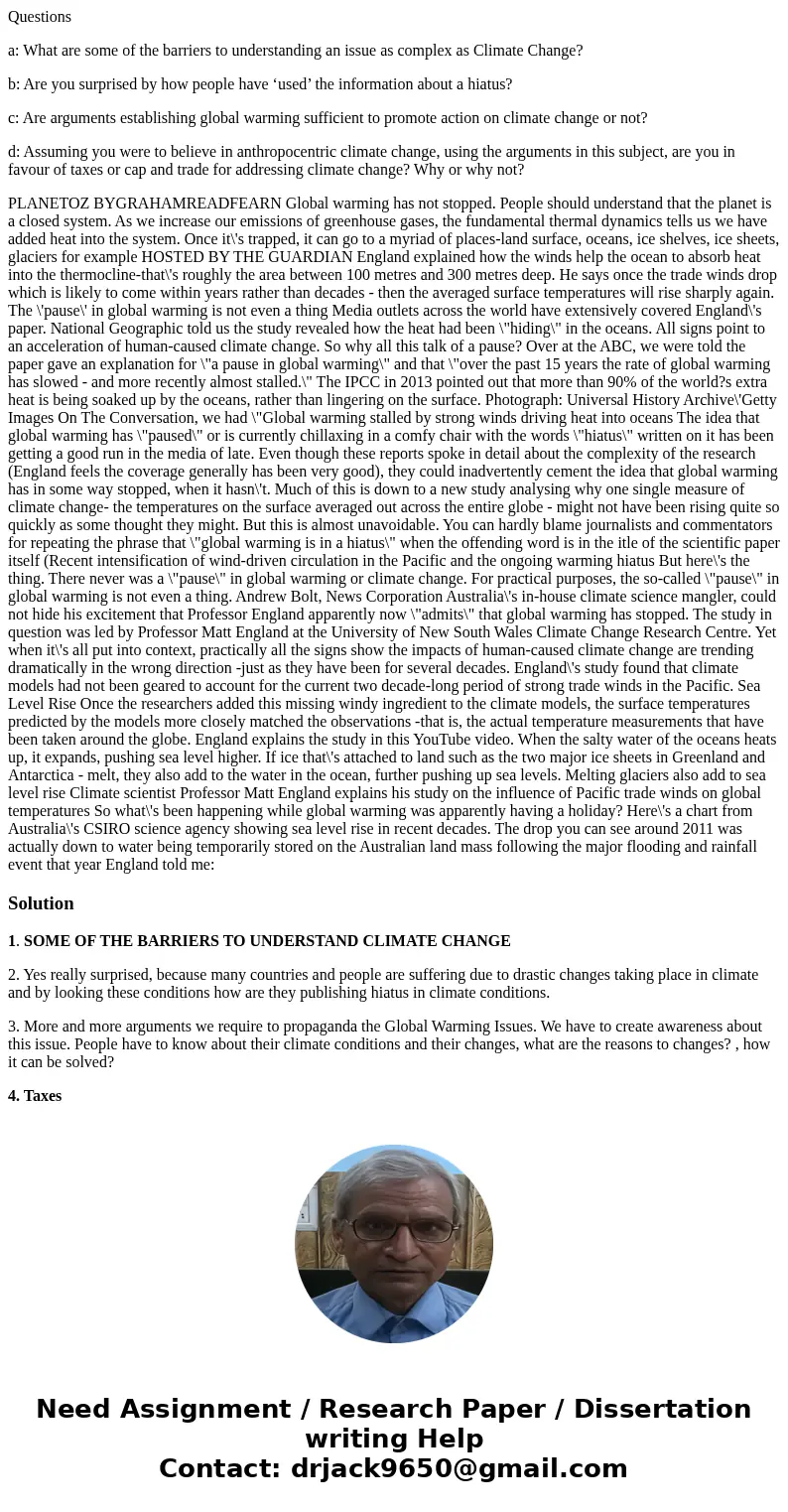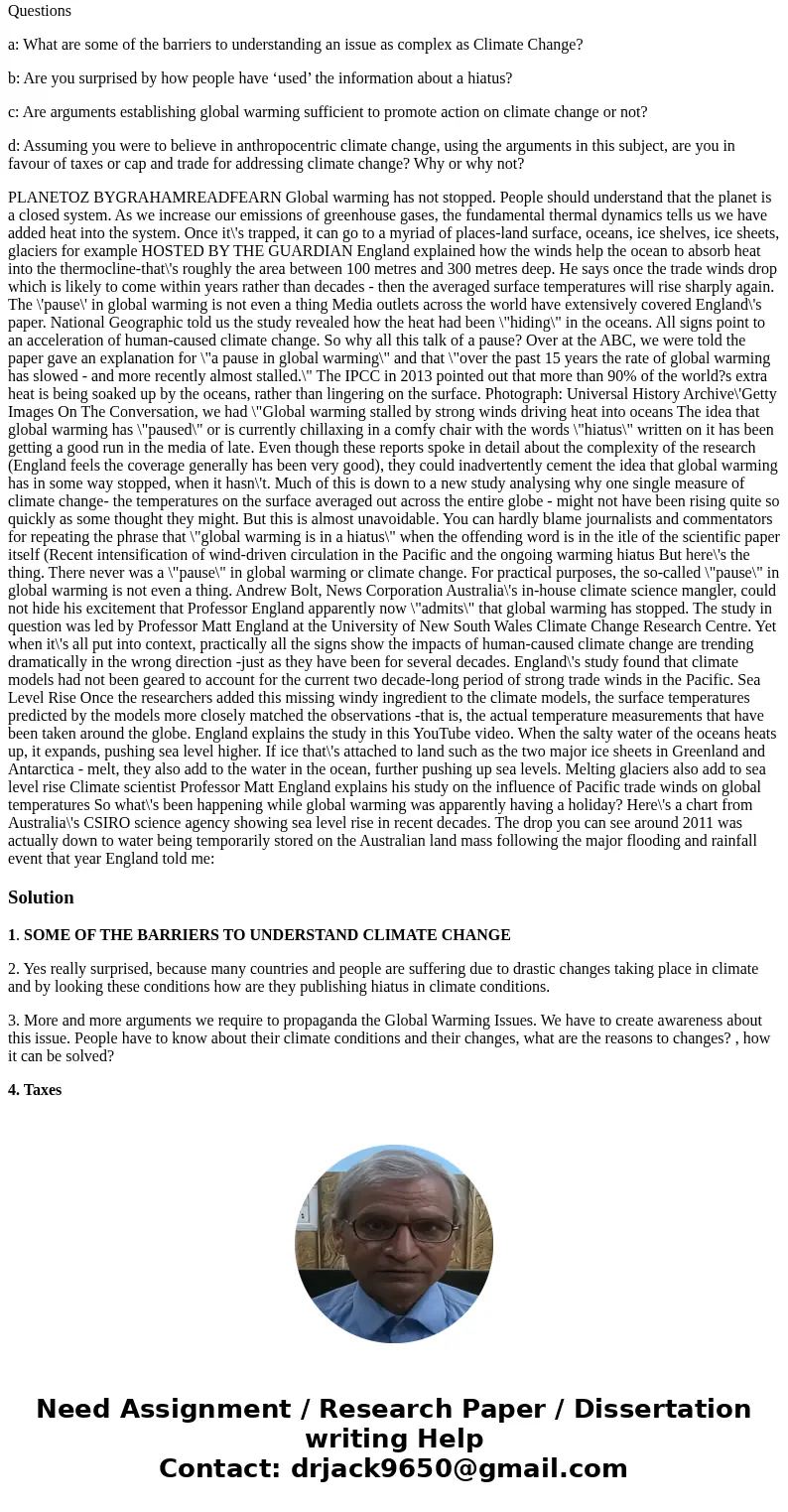Questions a What are some of the barriers to understanding a
Questions
a: What are some of the barriers to understanding an issue as complex as Climate Change?
b: Are you surprised by how people have ‘used’ the information about a hiatus?
c: Are arguments establishing global warming sufficient to promote action on climate change or not?
d: Assuming you were to believe in anthropocentric climate change, using the arguments in this subject, are you in favour of taxes or cap and trade for addressing climate change? Why or why not?
PLANETOZ BYGRAHAMREADFEARN Global warming has not stopped. People should understand that the planet is a closed system. As we increase our emissions of greenhouse gases, the fundamental thermal dynamics tells us we have added heat into the system. Once it\'s trapped, it can go to a myriad of places-land surface, oceans, ice shelves, ice sheets, glaciers for example HOSTED BY THE GUARDIAN England explained how the winds help the ocean to absorb heat into the thermocline-that\'s roughly the area between 100 metres and 300 metres deep. He says once the trade winds drop which is likely to come within years rather than decades - then the averaged surface temperatures will rise sharply again. The \'pause\' in global warming is not even a thing Media outlets across the world have extensively covered England\'s paper. National Geographic told us the study revealed how the heat had been \"hiding\" in the oceans. All signs point to an acceleration of human-caused climate change. So why all this talk of a pause? Over at the ABC, we were told the paper gave an explanation for \"a pause in global warming\" and that \"over the past 15 years the rate of global warming has slowed - and more recently almost stalled.\" The IPCC in 2013 pointed out that more than 90% of the world?s extra heat is being soaked up by the oceans, rather than lingering on the surface. Photograph: Universal History Archive\'Getty Images On The Conversation, we had \"Global warming stalled by strong winds driving heat into oceans The idea that global warming has \"paused\" or is currently chillaxing in a comfy chair with the words \"hiatus\" written on it has been getting a good run in the media of late. Even though these reports spoke in detail about the complexity of the research (England feels the coverage generally has been very good), they could inadvertently cement the idea that global warming has in some way stopped, when it hasn\'t. Much of this is down to a new study analysing why one single measure of climate change- the temperatures on the surface averaged out across the entire globe - might not have been rising quite so quickly as some thought they might. But this is almost unavoidable. You can hardly blame journalists and commentators for repeating the phrase that \"global warming is in a hiatus\" when the offending word is in the itle of the scientific paper itself (Recent intensification of wind-driven circulation in the Pacific and the ongoing warming hiatus But here\'s the thing. There never was a \"pause\" in global warming or climate change. For practical purposes, the so-called \"pause\" in global warming is not even a thing. Andrew Bolt, News Corporation Australia\'s in-house climate science mangler, could not hide his excitement that Professor England apparently now \"admits\" that global warming has stopped. The study in question was led by Professor Matt England at the University of New South Wales Climate Change Research Centre. Yet when it\'s all put into context, practically all the signs show the impacts of human-caused climate change are trending dramatically in the wrong direction -just as they have been for several decades. England\'s study found that climate models had not been geared to account for the current two decade-long period of strong trade winds in the Pacific. Sea Level Rise Once the researchers added this missing windy ingredient to the climate models, the surface temperatures predicted by the models more closely matched the observations -that is, the actual temperature measurements that have been taken around the globe. England explains the study in this YouTube video. When the salty water of the oceans heats up, it expands, pushing sea level higher. If ice that\'s attached to land such as the two major ice sheets in Greenland and Antarctica - melt, they also add to the water in the ocean, further pushing up sea levels. Melting glaciers also add to sea level rise Climate scientist Professor Matt England explains his study on the influence of Pacific trade winds on global temperatures So what\'s been happening while global warming was apparently having a holiday? Here\'s a chart from Australia\'s CSIRO science agency showing sea level rise in recent decades. The drop you can see around 2011 was actually down to water being temporarily stored on the Australian land mass following the major flooding and rainfall event that year England told me:Solution
1. SOME OF THE BARRIERS TO UNDERSTAND CLIMATE CHANGE
2. Yes really surprised, because many countries and people are suffering due to drastic changes taking place in climate and by looking these conditions how are they publishing hiatus in climate conditions.
3. More and more arguments we require to propaganda the Global Warming Issues. We have to create awareness about this issue. People have to know about their climate conditions and their changes, what are the reasons to changes? , how it can be solved?
4. Taxes


 Homework Sourse
Homework Sourse